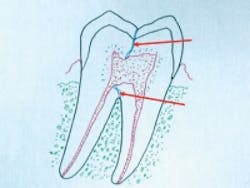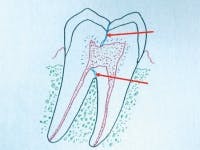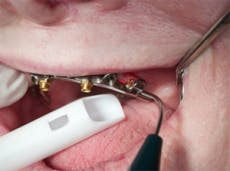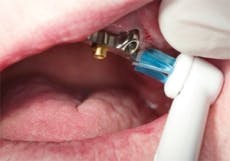The use of lasers in implant prosthodontics improves your bottom line
Joseph J. Massad, DDS
Welcome back! This month’s tip addresses the growing demand for the use of lasers in implant overdentureFIG. 1 — AMD Lasers / Dentsply: Picasso
FIG. 2 — Tissue overlapping underside of bar
Any trained practitioner can accomplish this procedure in seconds. It is my practice to have my laser in each operatory, ready to go at a moment’s notice. My practice is always evolving and it is not uncommon to utilize my laser five to 10 times a day. Lasers have become a permanent part of my implant overdenture armamentarium. Figure 1 shows my usual setup for implant abutment placement. Figure 2 shows the setting I generally use to excise fibrous tissue in the palatal areas. Figure 3 demonstrates contouring and excising tissue beneath a titanium milled bar to improve access for ease of cleaning. Figure 4 shows optimal brush tip configuration needed to clean bar and tissue.
FIG. 3 — Laser contouring under bar
This diode laser is perfect for contouring around implant abutments, specifically when the tissue is covering part of the retentive portion. Other uses include soft tissue curettage, removal of highly inflamed edematous tissue, excising unwanted tissue impeding properly designed prostheses, and more. For my prosthodontic needs, even if I utilize the laser without charging an additional fee to my patient, I have improved the overall result and saved postoperative recall time to correct any minor deficiencies that would have otherwise been neglected. I also have avoided the need to refer the patient to a specialist to clean up any of the situations I have discussed in this article. My efficiency and quality of treatment are enhanced with the use of the laser.
FIG. 4 — ProfessionalCare SmartSeries Power Tip electric toothbrush head
I encourage all of you who do not yet have lasers to consider evaluating and taking additional continued education courses in this area. You will open up new possibilities and relieve much of your frustration. I believe it will improve your efficiency and your financial bottom line. With the cost of good, dependable lasers at an all-time low, the timing may be right to jump in.
Until next month, I hope my pleasure in dentistry will also be yours.. . . Joe Massad
Dr. Joseph Massad may be reached by phone at (918) 749-5600 or by email at [email protected].
To see Dr. Massad’s video tips, visit www.DentalLibrary.com
Past DE Issues



